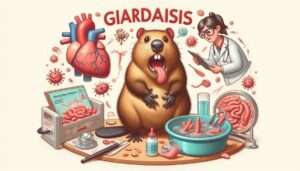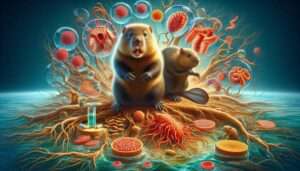Giardiasis: Understanding, Preventing and Treating the “Beaver Fever”
Giardiasis, often referred to as “beaver fever,” is a common intestinal infection that affects millions of people worldwide. This microscopic parasite can cause uncomfortable symptoms and disrupt your daily life.
In this comprehensive guide, we’ll explore everything you need to know about giardiasis, from its causes and symptoms to prevention and treatment options.
Anal STI Testing: A Comprehensive Guide to Protecting Your Sexual Health

Table of Contents
ToggleWhat is Giardiasis?
Giardiasis is an infection of the small intestine caused by the microscopic parasite Giardia lamblia (also known as Giardia intestinalis or Giardia duodenales). This single-celled organism is found in contaminated water, food, or surfaces and can survive in the environment for long periods.
The State of Sex Education in America: Challenges and Progress
According to the Centers for Disease Control and Prevention (CDC), giardiasis is one of the most common causes of waterborne disease in the United States, with an estimated 1.2 million cases occurring annually.

How is Giardiasis Transmitted?
Giardiasis spreads through the fecal-oral route, meaning that the parasite must be ingested to cause infection. Common transmission methods include:
1. Drinking contaminated water, especially from untreated sources like lakes or streams
2. Consuming food contaminated with Giardia cysts
3. Person-to-person contact, particularly in settings with poor hygiene
4. Contact with infected animals, especially dogs and cats
Travelers, hikers, campers, and children in daycare settings are at higher risk of contracting giardiasis.
Understanding STD Incubation Periods: A Comprehensive Guide

Symptoms of Giardiasis
Giardiasis symptoms typically appear 1-3 weeks after exposure to the parasite. However, it’s important to note that some people infected with Giardia may be asymptomatic. When symptoms do occur, they can include:
– Watery, foul-smelling diarrhea
– Abdominal cramps and bloating
– Nausea and vomiting
– Fatigue
– Weight loss
– Gas
– Greasy stools that may float
In some cases, symptoms can persist for weeks or even months if left untreated. Chronic giardiasis can lead to malabsorption of nutrients, potentially causing:
The Ultimate Guide to Condom Use: 15 Compelling Reasons to Wrap It Up
– Vitamin deficiencies
– Lactose intolerance
– Failure to thrive in children

Diagnosing Giardiasis
If you suspect you might have giardiasis, it’s crucial to seek medical attention. Diagnosis typically involves:
1. Physical examination: Your healthcare provider will assess your symptoms and medical history.
2. Stool tests: The most common diagnostic method is examining stool samples for Giardia cysts or antigens.
3. Intestinal biopsy: In rare cases, a small tissue sample may be taken from the small intestine for examination.
4. Blood tests: These may be used to check for complications or rule out other conditions.
Treatment Options for Giardiasis
While some cases of giardiasis may resolve on their own, treatment is often necessary to alleviate symptoms and prevent complications. Common treatment options include:
1. Antiparasitic medications: The primary treatment for giardiasis involves drugs such as:
– Metronidazole (Flagyl)
– Tinidazole (Tindamax)
– Nitazoxanide (Alinia)
2. Supportive care: Managing symptoms through hydration and rest is essential during recovery.
3. Follow-up testing: Your healthcare provider may recommend follow-up stool tests to ensure the infection has cleared.
It’s important to complete the full course of prescribed medication, even if symptoms improve before treatment is finished.
Preventing Giardiasis
Taking preventive measures can significantly reduce your risk of contracting giardiasis:
1. Practice good hygiene: Wash your hands thoroughly with soap and water, especially after using the bathroom, changing diapers, and before handling food.
2. Drink safe water: When traveling or camping, avoid drinking untreated water from lakes, streams, or wells. Use bottled water or treat water through boiling, filtration, or chemical disinfection.
3. Wash and cook food properly: Thoroughly wash fruits and vegetables and cook food to safe temperatures to kill any potential parasites.
4. Avoid swallowing water while swimming: Be cautious in pools, lakes, and other recreational water sources.
5. Practice safe sex: Use barrier methods during sexual activities, especially those involving oral-anal contact.
6. Take precautions when traveling: Be mindful of water and food safety in areas with poor sanitation.
Giardiasis in Special Populations
Certain groups may be at higher risk for complications from giardiasis or require special consideration:
Children:
– Giardiasis can cause developmental delays and failure to thrive in young children.
– Proper hygiene education in schools and daycares is crucial for prevention.
Pregnant women:
– Giardiasis during pregnancy may increase the risk of complications.
– Some antiparasitic medications may not be safe during pregnancy, so consult with a healthcare provider for appropriate treatment options.
Immunocompromised individuals:
– People with weakened immune systems may experience more severe or prolonged symptoms.
– They may require longer treatment courses or alternative medications.
The Environmental Impact of Giardiasis
Giardia can have significant impacts on wildlife and the environment:
– The parasite can infect various animal species, including beavers (hence the nickname “beaver fever”), muskrats, and other wildlife.
– Contaminated water sources can lead to widespread outbreaks in both human and animal populations.
– Understanding the ecological aspects of Giardia can help in developing more effective prevention strategies.
Living with Giardiasis: Diet and Lifestyle Considerations
During and after a giardiasis infection, certain dietary and lifestyle changes may help manage symptoms and support recovery:
1. Stay hydrated: Drink plenty of fluids to replace those lost through diarrhea.
2. Avoid certain foods: Temporarily reduce consumption of dairy products, fatty foods, and high-fiber foods that may exacerbate symptoms.
3. Probiotics: Consider taking probiotic supplements to support gut health and recovery.
4. Rest: Allow your body time to heal by getting adequate rest and sleep.
5. Gradual return to normal diet: Slowly reintroduce foods as symptoms improve, under the guidance of your healthcare provider.
Conclusion
Giardiasis is a common but preventable intestinal infection that can cause significant discomfort and health issues if left untreated. By understanding its causes, symptoms and prevention methods, you can take proactive steps to protect yourself and your loved ones.
Remember, if you suspect you have giardiasis or have been exposed to contaminated water or food, seek medical attention promptly. With proper treatment and preventive measures, you can effectively manage and avoid this parasitic infection.
Reference to External Sources:
[1] https://www.cdc.gov/parasites/giardia/index.html
[2] https://www.who.int/news-room/fact-sheets/detail/giardiasis
[3] https://www.mayoclinic.org/diseases-conditions/giardia-infection/symptoms-causes/syc-20372786
[4] https://www.ncbi.nlm.nih.gov/pmc/articles/PMC6040195/


